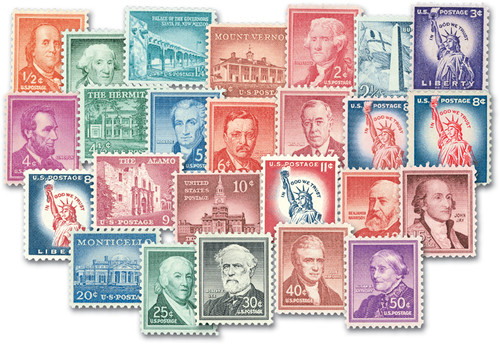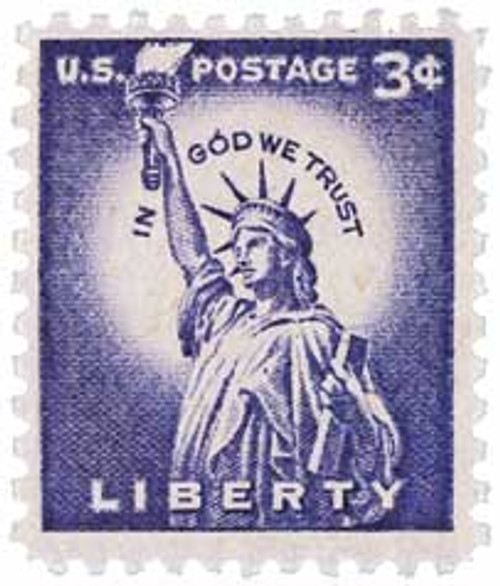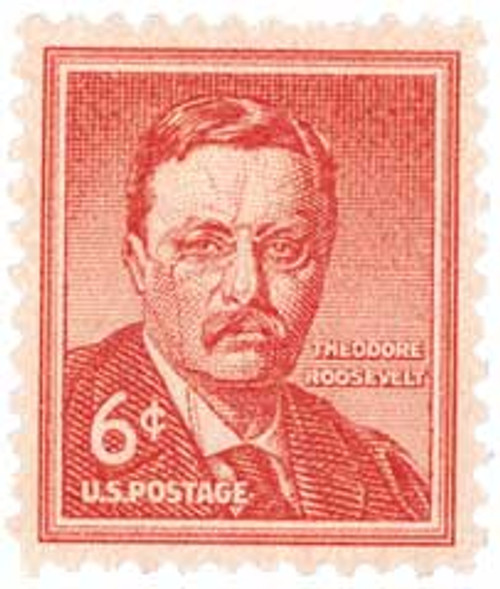
# 1033 - 1954 Liberty Series - 2¢ Thomas Jefferson
US #1033
1954 Thomas Jefferson, Carmine Rose
Liberty Series
• One of several varieties available to collect: wet- or dry-printed, coil or sheet, regular or silkote paper, with or without perforations, and more (see Scott Specialized Catalogue of United States Stamps & Covers for a full listing of varieties)
• Part of the Liberty Series
Stamp Category: Definitive
Series: Liberty
Value: 2¢ Postcard Rate
First Day of Issue: September 15, 1954
Printed by: Bureau of Engraving and Printing
Printing Method: Dry printing
Format: Sheets
Perforations: 11 x 10½
Color: Carmine Rose
Why the stamp was issued: To cover the 2¢ Postcard Rate and honor our third president.
About the stamp design: Pictures a portrait of President Thomas Jefferson. Designed by Tyler Dingee and William Schrage, engraved by Matthew D. Fenton, lettered by George L. Huber.
About the Liberty Series: The Liberty Series was first announced in late 1953 as a replacement for the popular Presidential Series (Prexies). The new series began on April 9, 1954, with the 8¢ Statue of Liberty stamp (for which the series was named).
The Liberty Series was quite different from the Prexies. It included “warm portraits” instead of “hard profile busts.” It also used the works of many different artists and photographers. Interestingly, former US presidents only made up a small portion of the stamp subjects (7 out of 25 denominations). The rest recognized other guardians of freedom throughout US history.
The Liberty Series was also produced with just 18 denominations as opposed to the 32 in the Presidential Series. The Liberty Series included definitive stamps ranging from ½¢ to $5. It was the last time the US produced a ½¢ stamp.
During its run, the Liberty Series was part of a Bureau of Engraving and Printing experiment that began in 1954. In previous “wet” printings, the paper had a moisture content of 15 to 35 percent. In the experimental “dry” printings, the paper had a moisture content of 5 to 10 percent. This process required stiffer, thicker paper, special inks, and greater pressure to force the paper through the plates. Stamps produced by dry printing can be distinguished by whiter paper and higher surface sheen. The stamps feel thicker and the designs are more pronounced than on wet printings. The dry printing experiment was a success, and all US postage stamps have been printed this way since the late 1950s.
The Liberty Series ran from 1954-61 and was replaced by the Prominent Americans Series in 1965. However, the 2¢ and 25¢ coil stamps were reprinted many times and sold well into the 1980s.
History the stamp represents: Thomas Jefferson was born on April 13, 1743, in Shadwell, Virginia. He was an outstanding writer (responsible for our Declaration of Independence), America’s first Secretary of State, vice president to John Adams, and third president of the United States. He was also responsible for the United States’s purchase of the Louisiana Territory from France, which doubled the size of our country at a cost of less than 3¢ per acre.
Check out Mystic’s This Day in History article to learn more about Jefferson…
US #1033
1954 Thomas Jefferson, Carmine Rose
Liberty Series
• One of several varieties available to collect: wet- or dry-printed, coil or sheet, regular or silkote paper, with or without perforations, and more (see Scott Specialized Catalogue of United States Stamps & Covers for a full listing of varieties)
• Part of the Liberty Series
Stamp Category: Definitive
Series: Liberty
Value: 2¢ Postcard Rate
First Day of Issue: September 15, 1954
Printed by: Bureau of Engraving and Printing
Printing Method: Dry printing
Format: Sheets
Perforations: 11 x 10½
Color: Carmine Rose
Why the stamp was issued: To cover the 2¢ Postcard Rate and honor our third president.
About the stamp design: Pictures a portrait of President Thomas Jefferson. Designed by Tyler Dingee and William Schrage, engraved by Matthew D. Fenton, lettered by George L. Huber.
About the Liberty Series: The Liberty Series was first announced in late 1953 as a replacement for the popular Presidential Series (Prexies). The new series began on April 9, 1954, with the 8¢ Statue of Liberty stamp (for which the series was named).
The Liberty Series was quite different from the Prexies. It included “warm portraits” instead of “hard profile busts.” It also used the works of many different artists and photographers. Interestingly, former US presidents only made up a small portion of the stamp subjects (7 out of 25 denominations). The rest recognized other guardians of freedom throughout US history.
The Liberty Series was also produced with just 18 denominations as opposed to the 32 in the Presidential Series. The Liberty Series included definitive stamps ranging from ½¢ to $5. It was the last time the US produced a ½¢ stamp.
During its run, the Liberty Series was part of a Bureau of Engraving and Printing experiment that began in 1954. In previous “wet” printings, the paper had a moisture content of 15 to 35 percent. In the experimental “dry” printings, the paper had a moisture content of 5 to 10 percent. This process required stiffer, thicker paper, special inks, and greater pressure to force the paper through the plates. Stamps produced by dry printing can be distinguished by whiter paper and higher surface sheen. The stamps feel thicker and the designs are more pronounced than on wet printings. The dry printing experiment was a success, and all US postage stamps have been printed this way since the late 1950s.
The Liberty Series ran from 1954-61 and was replaced by the Prominent Americans Series in 1965. However, the 2¢ and 25¢ coil stamps were reprinted many times and sold well into the 1980s.
History the stamp represents: Thomas Jefferson was born on April 13, 1743, in Shadwell, Virginia. He was an outstanding writer (responsible for our Declaration of Independence), America’s first Secretary of State, vice president to John Adams, and third president of the United States. He was also responsible for the United States’s purchase of the Louisiana Territory from France, which doubled the size of our country at a cost of less than 3¢ per acre.
Check out Mystic’s This Day in History article to learn more about Jefferson…




















